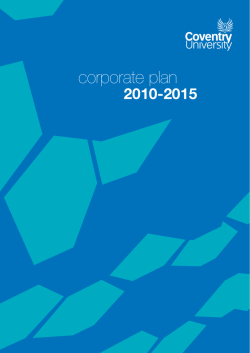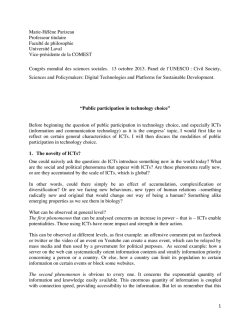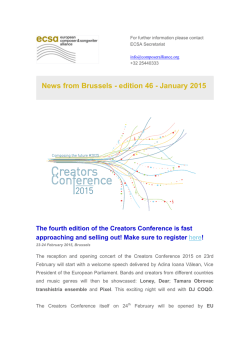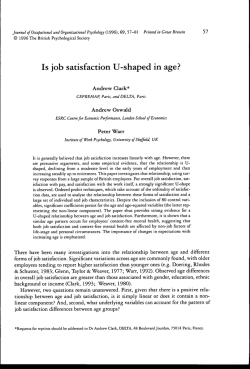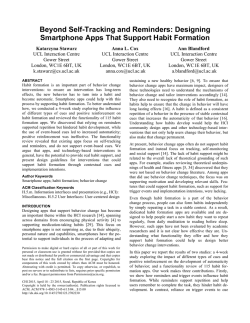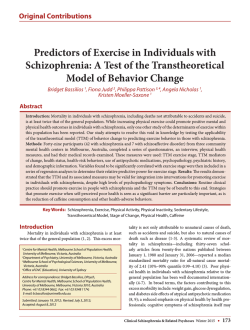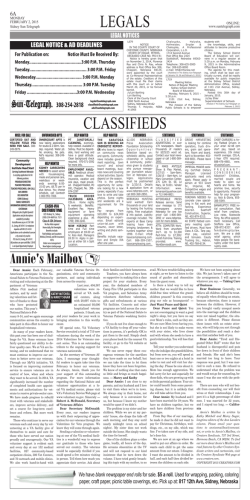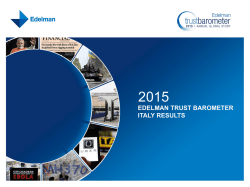
The sources and Conseguences of Mobile
Association for Information Systems AIS Electronic Library (AISeL) PACIS 2014 Proceedings Pacific Asia Conference on Information Systems (PACIS) 2014 THE SOURCES AND CONSEQUENCES OF MOBILE TECHNOSTRESS IN THE WORKPLACE Pengzhen Yin City University of Hong Kong, [email protected] Robert M. Davison City University of Hong Kong, [email protected] Yiyang Bian City University of Hong Kong, [email protected] Ji Wu University of Science and Technology, [email protected] Liang Liang University of Science and Technology of China, [email protected] Follow this and additional works at: http://aisel.aisnet.org/pacis2014 Recommended Citation Yin, Pengzhen; Davison, Robert M.; Bian, Yiyang; Wu, Ji; and Liang, Liang, "THE SOURCES AND CONSEQUENCES OF MOBILE TECHNOSTRESS IN THE WORKPLACE" (2014). PACIS 2014 Proceedings. Paper 144. http://aisel.aisnet.org/pacis2014/144 This material is brought to you by the Pacific Asia Conference on Information Systems (PACIS) at AIS Electronic Library (AISeL). It has been accepted for inclusion in PACIS 2014 Proceedings by an authorized administrator of AIS Electronic Library (AISeL). For more information, please contact [email protected]. THE SOURCES AND CONSEQUENCES OF MOBILE TECHNOSTRESS IN THE WORKPLACE Pengzhen Yin, USTC-CityU Joint Advanced Research Center, University of Science and Technology, City University of Hong Kong, 83 Tat Chee Avenue, Kowloon Tong, Hong Kong, [email protected] Robert M. Davison, City University of Hong Kong, Hong Kong, China, [email protected] Yiyang Bian, USTC-CityU Joint Advanced Research Center, University of Science and Technology, City University of Hong Kong, 83 Tat Chee Avenue, Kowloon Tong, Hong Kong, [email protected] Ji Wu, USTC-CityU Joint Advanced Research Center, University of Science and Technology, City University of Hong Kong, 83 Tat Chee Avenue, Kowloon Tong, Hong Kong, [email protected] Liang Liang, University of Science and Technology of China, Hefei, Anhui, China, [email protected] Abstract In this study, we explore the phenomenon of mobile technostress: stress experienced by users of mobile information and communication technologies. We examine the impacts of mobile technostress on individuals’ job satisfaction. Based on the Transaction Based Model of stress and the existing literature on technostress, a conceptual model was proposed to understand this phenomenon. Two sources of mobile technostress have been identified: techno-overload and techno-insecurity. We hypothesize that techno-overload and techno-insecurity exert a negative impact on job satisfaction. The individual level mobile technostress inhibitors (i.e., self-efficacy) are identified as helping individuals reduce stress. We also hypothesize that self-efficacy has a positive impact on job satisfaction. Furthermore, the moderator effects of habit are also explored. We hypothesize that habit will negatively moderate the relationship between mobile technostress creators and job satisfaction, and positively moderate the relationship between mobile technostress inhibitors and job satisfaction. The methodological design as well as potential theoretical and practical implications has also been discussed. Keywords: mobile technostress, mobile information and communication technologies (MICTs), habit, job satisfaction. 1 INTRODUCTION In recent years, a number of researchers have studied a phenomenon named technostress (Tarafdar et al. 2007; Weil and Rosen 1997), which has been attributed to the explosive growth and over use of technologies. Technostress refers to individuals’ feelings of stress due to the use of ICTs. The most widely used definition of technostress in the literature is “a modern disease of adaptation caused by an inability to cope with new computer technologies in a healthy manner” (Brod 1984). Technostress can directly result in physical and mental strains for individuals, such as high blood pressure, heart disease and musculoskeletal disorders (Pransky et al. 2002). Thus, technostress negatively impacts on employees’ psychological and physical health. The practical evidence also indicates that technostress also leads to perceived work overload, information overload, loss of motivation, and job dissatisfaction (Weil and Rosen 1997). Recent studies have demonstrated that technostress has negative effects on some important organizational outcomes. For example, it has led to decreases in productivity and organizational commitment, and increases in employee turnover (Ahmad et al. 2012; Tarafdar et al. 2011). Unsurprisingly, technostress has increasingly attracted the attention of academics. However, existing studies rarely focus on technostress associated with Mobile Information and Communication Technologies (MICTs). Some technostress studies involving individuals focus exclusively on stationary ITs (Ragu-Nathan et al. 2008; Tarafdar et al. 2007; Tu et al. 2005). Others have studied the comprehensive influence of stationary and mobile technologies on individual and organizational outcomes (Ayyagari et al. 2011). Recent research has seen a focus on the negative effects of one single MICT, such as the smart phone (Yun et al. 2012). However, little attention is being paid to a general understanding of MICTs’ influence on users (Sorensen and Gibson 2008). Yoo and his colleagues also emphasized that little effort has been made to understanding the MICTs within the IS field (Yoo et al. 2010). In the absence of this understanding, this study proposes a conceptual model to understand mobile technostress and its influence on employees’ job satisfaction. This work-in-progress paper proceeds as follows. Section 2 reviews and illustrates the phenomenon of mobile technostress. In section 3, we review the related literature on stress and the corresponding outcomes and effects of MICTs. In section 4, a conceptual model for understanding the impact of MICTs on individuals is proposed. Finally, the research methodology design, as well as the potential theoretical and practical implications, is discussed. 2 MOBILE TECHNOSTRESS In recent years, organizations have improved productivity by permitting employees to use MICTs at work. Furthermore, an increasing number of consumer sector innovations have infiltrated organizations (Weiss and Leimeister 2012). This trend has resulted in the widespread use of MICTs in organizations. MICTs have also become an important part of the organizational technological environment, especially in the context of IT consumerization. In this study, MICTs have been defined as portable IT artifacts that include hardware/devices, software/applications, and network services (Jarvenpaa and Lang 2005). It is expected that MICTs will have a lasting impact on both individuals and organizations. In the existing literature, ubiquitous technostress has been recognized as “the users of a mobile technology who are familiar with the current operating technology encountering specific stress caused by the characteristics of mobility and/or reachability of the technology or suffering for a long period of time through continual connection with that particular mobile technology” (Hung et al. 2011). Kuo et al. (2009) suggested that individuals may experience mobile technostress when they feel an imbalance between using MICTs and not being able to use MICTs. Because of their widespread use and ubiquitous nature, MICTs have significantly changed individuals’ way of work and life. MICTs promote the co-existence of a more flexible workplace with demands for continuous connection, frequent interruption, and more complex work arrangements. Individuals may experience high levels of anxiety and sense a loss of control as a result (Hung et al. 2011). There are few existing studies about mobile technostress (Hung et al. 2011; Kuo et al. 2009). The studies of mobile technostress are theoretically based on technostress and organizational stress. Yu et al. (2009) and Kuo et al. (2009) summarized four components that characterize the phenomenon of mobile technostress, i.e., technology, stress, technostress, and mobile technology. They pointed out that individuals will perceive stress while losing control due to use of mobile technologies. According to the Transaction Based Model (TBM), Hung et al. (2011) investigated the phenomenon of mobile technostress by identifying mobile technostress creators and mobile technostress inhibitors. Lee et al. (2012) established that technostress has a negative impact on continuous use of smartphones. Yun et al. (2012) also indicated that the use of an office-home smartphone (OHS) will result in work-life conflict and eventually increase job stress. 3 THEORETICAL BACKGROUND Most studies in the field of technostress are based on the TBM (Ragu-Nathan et al. 2008; Tarafdar et al. 2011). This model has four major components: stressors, situational factors, strain, and other organizational outcomes (Figure 1). Stressors refer to the factors which can create stress. They can be classified into two categories: role-related stressors and task-related stressors. Situational factors are organizational mechanisms that reduce stress, such as, stress management training, role restructuring, information sharing and social support. Strain refers to psychological, physiological and behavioral outcomes of stress that can be observed in individuals. The most widely studied term in the technostress literature is behavioral strain. Examples include job dissatisfaction and lack of creativity. Strain can lead to other organizational outcomes, for example, absenteeism and turnover. Stressors Strain Situation Factors Figure 1. Other Organizational Outcomes The Transaction-Based Model of Stress. In general, there is a positive relationship between stressors and strain, i.e. stressors increase strain. Correspondingly, situational factors, e.g. organizational technological support (Nelson 1990), may act to reduce strain, as well as influencing other organizational outcomes. Prior studies reflected that situational factors can moderate the relationship between stressors and strain. There are strong empirical evidences to support the existence of a relationship between stressors and strain. But the moderating effect of situational factors is not sufficient according to the existing literature (Cooper et al. 2001). For instance, Ragu-Nathan et al. (2008) has reviewed that several studies have verified that job control has a moderating effect on the relationship between job demands and worker well-being, while other factors do not exert this moderating effect. 4 HYPOTHESES DEVELOPMENT Figure 2 shows the conceptual model of this study. It is based on the TBM (Figure 1). Ragu-Nathan et al. (2008) have proposed two constructs corresponding to stressor and situational factors in Figure 1 respectively, that is, technostress creators and technostress inhibitors. Accordingly, in this study, the mobile technostress creators and mobile technostress inhibitors are used to represent the stressors and situational factors. Otherwise, we also choose the job satisfaction to represent the stain factor in Figure 1. Habit Mobile Technostress Creators Techno-overload H3a1 H3a2 - H1a - H3b + Techno-insecurity H1b - Job Satisfaction Mobile Technostress Inhibitors H2 Self-efficacy Figure 2 4.1 Conceptual Model for Understanding Mobile Technostress in Organization Job Satisfaction Job satisfaction has been defined as “a pleasurable or positive emotional state resulting from the appraisal of one’s job or job experiences” (Locke 1976). It has been widely studied as a behavioral strain variable in the existing stress literature. However, in the mobile context, promoted by the trend of IT consumerization, individuals voluntarily bring their mobile devices to help them deal with work tasks. In this way, they feel satisfied with their job by using MICTs. On the other hand, MICTs have created other problems that frequently influence individuals, such as work interruption (Jarvenpaa and Lang 2005; Ou and Davison 2011). Therefore, in the mobile context, the relationship between MICTs’ use and job satisfaction is still unclear, which is why further study is needed. 4.2 Mobile Technostress Creators In the current technostress literature, scholars have identified five widely-accepted technostress creators (Ragu-Nathan et al. 2008; Tarafdar et al. 2007; Tu et al. 2005). These five creators are: techno-overload (which refers to situations where users are forced to work faster and longer by using ICTs); techno-invasion (which refers to the invasive effect of ICTs which blur work-life boundaries); techno-complexity (which refers to situations where the complexity of ICTs induce users’ feeling of inadequate with respect to their computer skills; users are forced to spend time and effort to learn and understand ICTs); techno-insecurity (which refers to users’ feeling of being threatened about losing their jobs, due to automation from ICTs or others who have a better understanding of ICTs); and techno-uncertainty (which refers to situations where continuing changes and upgrades of ICTs unsettle users and create uncertainty that users have to constantly learn and educate themselves about new ICTs). However, by using MICTs in the workplace, individuals will experience information and communication overload, as well as interruption overload (Ragu-Nathan et al. 2008). These effects result in cognitive overload (Kirsch 2000) and cumulatively result in a techno-overload as they have to work faster and for longer hours. Thus, techno-overload describes situations where MICTs force individuals to work faster and continuously. On the other hand, the mobile and ubiquitous natures of MICTs lead to the pervasive effects of MICTs: users can be reached and connected anywhere and anytime. Individuals are then forced to pay more attention to MICTs to avoid missing any information or communication, which may threaten their job performance. In these cases, more individuals experience techno-insecurity by using MICTs in the workplace. Therefore, we suggest that techno-insecurity describes situations where individuals feel that their job stability is threatened because of the potential to miss important information compared to others who get the same information more effectively and efficiently. Furthermore, as mentioned before, the mobile and ubiquitous nature of MICTs indicates the pervasive effects which render users connectable anytime and anywhere. However, in most cases, the MICTs are voluntarily used by individuals in both their personal lives and in the workplace (May 2012). It is still unclear whether the blurred work-life boundary increases individual strains or not. Therefore, because of the voluntary use of MICTs, the techno-invasion effects are not as significant as those of traditional ICTs. Given the voluntary use of MICTs in the workplace, we can assume that individuals has adopted and brought them into their work context. According to the Technology Acceptance Model (Davis et al. 1989), individuals perceive that the MICTs are useful and easy to use, so technocomplexity and techno-uncertainty are not included in this study. Generally speaking, MICTs can create technostress due to the paradoxical effects faced by individuals. MICTs enable individuals to deal simultaneously with various kinds of information from different sources (Ragu-Nathan et al. 2008; Tarafdar et al. 2011). A large amount of information from external or internal sources comes together, and this trend has become increasingly apparent and severe by MICTs which provide multiple formats and channels for its communication. This trend has lead to individuals experiencing information overload (Bawden and Robinson 2009). They feel frustrated, are unable to cope with problems and make decisions paralyzed by too much information (Edmunds and Morris 2000). Furthermore, the existing literature also suggests that technology-mediated interruptions lead to stress in individuals by breaking continuous concentration on the current task, resulting in frustration (Ren et al. 2008). These phenomena may create stress and make individuals feel frustrated, exhausted and dissatisfied. Therefore, we hypothesize that: H1a: Techno-overload has a negative impact on job satisfaction. Techno-insecurity refers to “situations where users feel threatened about losing their jobs, either because of automation from ICTs or to other people who have a better understanding of ICTs” (RaguNathan et al. 2008). Using MICTs has not only become a personal preference but also a social norm (Agarwal and Karahanna 2000). Everyone is considered ready to be contacted by MICTs. Therefore, leaving MICT devices at home, or running out of battery, have become inexcusable and can easily lead to social exclusion (Jarvenpaa and Lang 2005). This has increased individuals’ feeling of missing important work-related information which may threaten their job status. In addition, organizations deploy MICTs in order to accelerate operational processes and improve efficiency (Sheedy 2010). This has improved the fluency of information flows and work flows by providing anywhere and anytime computing (Sheng et al. 2005). Therefore, individuals are controlled in the workflows and an individual’s current work status is easily identified by others (Yoo et al. 2010). In this way, individuals are forced to work more effectively and efficiently than before, which potentially threatens their job performance. Therefore, individuals are experiencing extended periods of anxiety and the feeling of threats to their job stability which reduce the job satisfaction. Thus, we hypothesize that: H1b: Techno-insecurity has negative impact on job satisfaction. 4.3 Mobile Technostress Inhibitors In the Transaction Based Model, the situational variables refer to organizational mechanisms that reduce stress. However, the MICTs are used and kept by individuals in different ways and situations. It’s hard for organizations to provide unified mechanisms to reduce employees’ stress effectively. Therefore, it’s important to consider the individual level inhibitors. Self-efficacy is an important individual trait that affects individuals’ use of technologies as well as the reaction to technologies (Compeau and Higgins 1995). It has been defined as “individuals’ beliefs about their capabilities to produce designated levels of performance that exercise influence over events that affect their lives” (Bandura 1994). A strong sense of self-efficacy gives individuals a high degree of assurance in their personal ability to deal with difficult tasks. Individuals are more likely to sustain their efforts in the face of failure. They are more likely to attribute failure to deficiency of knowledge, skill and effort rather than their capability. In this way, individuals always feel control of the existing situation which may reduce stress and feeling of depression. Therefore, individuals will have high job satisfaction. H2: Self-efficacy has a positive impact on job satisfaction. 4.4 Habit In social psychology research, habit has been defined as “Learned sequences of acts that have become automatic responses to specific cues, and are functional in obtaining certain goals or end-states” (Verplanken and Aarts 1999). Habits can improve individuals’ efficiency by freeing the mental capacity to do other things in parallel. Specifically, the efficiency of habits appears in particular under conditions of heavy load, such as exhaustion, time pressure, distraction, or information overload (Verplanken and Orbell 2003). Therefore, habits can reduce individuals’ negative feeling while experiencing negative effects in the workplace. Furthermore, non-habitual behavior is associated with lowered feelings of self-regulation and control compared with habits (Wood et al. 2002). That is, habit performance does not require deliberation and thus is not likely to elicit control deficits. However, the deliberation involved in non-habitual behavior may induce self-regulatory strains, such as individuals’ feelings of stress, loss of control and helplessness. Based on the improvement of efficiency, feeling of control and self regulation, the habits of MICT users in the workplace make them more tolerant of mobile technostress creators. In this way, individuals experience less psychological stress, and may perceive more positive effects of using MICTs. Therefore, individuals’ job satisfaction may be improved. Habit is a part of how we organize everyday life. It may reflect a sense of identity or personal style (Verplanken and Orbell 2003). Therefore, habit can reflect the degree of an individual’s self-efficacy. It will also have an impact on the relationship between mobile technology inhibitors and job satisfaction. Therefore, we hypothesize: H3a1: Habit will negatively moderate the relationship between techno-overload and job satisfaction. H3a2: Habit will negatively moderate the relationship between techno-insecurity and job satisfaction. H3b: Habit will positively moderate the relationship between self-efficacy and job satisfaction. 5 DISCUSSION In order to ensure the rigor of the study, we provide supplementary consideration on measurement of the research model. Preliminary work for data collection and implementation are discussed. We used the survey method to verify the research model. To guarantee the validity and reliability of the study, we advocate a two-step approach to constitute and verify the instrument. Firstly, we will briefly illustrate the development and validation of measures. Where possible, the measures in this study are adapted from existing literature. For the independent variables, the measurement of techno-insecurity is adapted from Ragu-Nathan et al. (2008) based on its conceptual definition. With respect to the techno-overload, we defined three second-order constructs: information overload, which refers to the degree to which users feel that the input amount of information or information processing speed exceeds their own processing capacity; communication overload, which refers to the degree to which users feel overloaded through too much or continuous communication; and interruption overload, which describes the degree to which a user is frequently disturbed by unplanned interactions through MICTs. The measurements of these constructs are developed based on the procedure outlined in Moore and Benbasat (1991). The measurement scale of self-efficacy can be found in Schwarzer et al. (1997) and Sherer and Maddux (1982) . The dependent variable’s (i.e., job satisfaction) measurement is adapted from Ragu-Nathan et al. (2008). The measurement of the moderator (i.e., habit) is adapted from Verplanken and Orbell (2003). Secondly, a pilot study was conducted with a sample of 30 Chinese postgraduate students from a university in mainland China. During this process, we collected feedback on the questionnaire that enabled us to further revise the measurement used in the following large-scale data collection process. The respondents will be working professionals who use MICTs in their work context. All items are measured with seven-point Likert scales anchored at agree and disagree. We plan to use structural equation modeling techniques to analyze the structural model. The construct validity and reliability will be analyzed using SPSS and Partial Least Squares (PLS). The convergent validity can be examined by factor loadings, while discriminant validity can be confirmed by the square of AVE. Common method bias will also be tested (Podsakoff and Organ 1986). The significance test, together with the coefficient parameters, can indicate whether the proposed hypotheses are supported or not. Furthermore, we also plan to conduct follow-up interviews in order to review the empirical results. We will collect feedback from both employees and managers. This feedback can also help us link the empirical research with the organizational strategies on reducing individual mobile technostress and improving job satisfaction. Therefore, we argue that this study makes both academic and potential practice contributions in the following respects. Theoretically, we identify two main technostress creators based on the mobility and ubiquitous nature of MICTs in the work context. Furthermore, we extend the boundary of TBM by examining the moderator effect of habit on the relationships between technostress creators and strain, and relationship between technostress inhibitors and strain. This study also has potential practical implications. The results may give some guidance to organizations as well. Human resources are one of the most valuable resources, so concern for employee health will effectively improve the productivity of an organization. Our study can help managers understand individuals’ daily reaction by using MICTs in workplace. Furthermore, we can also propose some useful suggestions on how to manage the use of MICTs in workplace, and how to improve employees’ job satisfaction by using MICTs in workplace. References Agarwal, R., and Karahanna, E. (2000). Time flies when you're having fun: Cognitive absorption and beliefs about information technology usage. MIS Quarterly, 24(4), 665-694. Ahmad, U.N.U., Amin, S.M., and Ismail, W.K.W. (2012). The relationship between technostress creators and organisational commitment among academic librarians. Asia Pacific Business Innovation and Technology Management Society, 40, 182-186. Ayyagari, R., Grover, V., and Purvis, R. (2011). Technostress: Technological antecedents and implications. MIS Quarterly, 35(4), 831-858. Bandura, A. (1994). Self-efficacy. In V. S. Ramachaudran (Ed.), Encyclopedia of Human Behavior. New York: Academic Press, 4, 71-81. Bawden, D., and Robinson, L. (2009). The dark side of information: Overload, anxiety and other paradoxes and pathologies. Journal of Information Science, 35, 180-191. Brod, C. (1984). Technostress: The human cost of the computer revolution. MA.: Addison-Wesley, Reading. Compeau, D.R., and Higgins, C.A. (1995). Computer self-efficacy: Development of a measure and initial test. MIS Quarterly, 19(2), 189-211. Cooper, C.L., Dewe, P., and O'Driscoll, M.P. (2001). Organizational stress: A review and critique of theory, research and applications. CA.: Sage, Thousand Oaks. Davis, F.D., Bagozzi, R.P., and Warshaw, P.R. (1989). User acceptance of computer technology: A comparison of two theoretical models. Management Science, 35(8), 982-1003. Edmunds, A., and Morris, A. (2000). The problem of information overload in business organizations a review of the literature. International Journal of Information Management, 20, 17-28. Hung, W.H., Chang, L.M., and Lin, C.H. 2011. "Managing the risk of overusing mobile phones in the working environment: A study of ubiquitous technostress," the 15th PACIS, Brisbane, Australia. Jarvenpaa, S.L., and Lang, K.R. (2005). Managing the paradoxes of mobile technology. Information Systems Management, 22(4), 7-23. Kirsch, D. ( 2000). A few thoughts on cognitive overload Intellectica, 30, 19–51. Kuo, L.H., Chen, L.M., Yang, H.J., Yang, H.H., Yu, J.C., and Wen-Chen, H. 2009. "Assessing mobile technostress," the 8th WSEAS International Conference on Telecommunications and Informatics, pp. 37-42. Lee, S.J., Jin, S.H., and Choi, B.J. 2012. "The influence of technostress and anti-smart on continous use of smartphones," the World Congress on Engineering and Computer Science, San Francisco, USA. Locke, E.A. (1976). The nature and causes of job satisfaction. In M. D. Dunnette (Eds). Handbook of Industrial and Organizational Psychology. Chicago, Rand-McNally, 1297–1350. May, T. (2012). The impact of consumerization of it - turning byod, the cloud, and other trends to your advantage. AIIM Executive Leadership Council, 1-28. Moore, G.C., and Benbasat, I. (1991). Development of an instrument to measure the perceptions of adopting an information technology innovation. Information Systems Research, 2(3), 192-222. Nelson, D.L. (1990). Individual adjustment to information-driven technologies: A critical review. MIS Quarterly, 14(1), 79–98. Ou, C.X.J., and Davison, R.M. (2011). Interactive or interruptive? Instant messaging at work. Decision Support Systems, 52(1), 61-72. Podsakoff, P.M., and Organ, D.W. (1986). Self-reports in organizational research: Problems and prospects. Journal of Management, 12(4), 531-544. Pransky, G., Robertson, M.M., and Moon, S.D. (2002). Stress and work-related upper extremity disorders implications for prevention and management. American Journal of Industrial Medicine, 41(5), 443-455. Ragu-Nathan, T.S., Tarafdar, M., Ragu-Nathan, B.S., and Tu, Q. (2008). The consequences of technostress for end users in organizations: Conceptual development and empirical validation. Information Systems Research, 19(4), 417-433. Ren, Y., Kiesler, S., and Fussell, S.R. (2008). Multiple group coordination in complex and dynamic task environments: Interruptions, coping mechanisms, and technology recommendations. Journal of Management Information Systems, 25(1), 105-130. Schwarzer, R., Babler, J., Kwiatek, P., Schroder, K., and Zhang, J.X. (1997). The assessment of optimistic self-beliefs: Comparison of the german, spanish, and chinese versions of the general self-efficacy scale. Applied Psychology: An International Review, 46(1), 69-88. Sheedy, T. (2010). Insights for cios: Make mobility standard business practice. Forrester Research. Sheng, H., Nah, F.F.H., and Siau, K. (2005). Strategic implications of mobile technology: A case study using value-focused thinking. Journal of Strategic Information Systems, 14(3), 269-290. Sherer, M., and Maddux, J.E. (1982). The self-efficacy scale: Construction and validation. Psychological Reports, 51(2), 663-671. Sorensen, C., and Gibson, D. (2008). The professional's everyday struggle to ubiquitize computers. In M. Elliott and K. Kraemer (Eds). Computerization Movements and Technology Diffusion: From Mainframes to Ubiquitous Computing. Medford, NJ: Information Today, 455-479. Tarafdar, M., Tu, Q., Ragu-Nathan, B.S., and Ragu-Nathan, T.S. (2007). The impact of technostress on role stress and productivity. Journal of Management Information Systems, 24(1), 301-328. Tarafdar, M., Tu, Q., Ragu-Nathan, T.S., and Ragu-Nathan, B.S. (2011). Crossing to the dark side: Examining creators, outcomes, and inhibitors of technostress. Communications of the ACM, 54(9), 113-120. Tu, Q., Wang, K.L., and Shu, Q. (2005). Computer-related technostress in china. Communications of the ACM, 48(4), 77-81. Verplanken, B., and Aarts, H. (1999). Habit, attitude, and planned behavior: Is habit an empty construct or an interesting case of goal-directed automaticity? In W. Stroebe & M. Hewstone (Eds.), European Review of Social Psychology, Chichester, England: Wiley, 10, 101–134. Verplanken, B., and Orbell, S. (2003). Reflections on past behavior: A self-report index of habit strength. Journal of Applied Social Psychology, 33(6), 1313-1330. Weil, M.M., and Rosen, L.D. (1997). Technostress: Coping with technology @ work, @ home, @ play. New York: Wiley. Weiss, F., and Leimeister, J.M. (2012). It innovations from the consumer market as a challenge for corporate it. Business & Information Systems Engineering, 6, 363-366. Wood, W., Quinn, J.M., and Kashy, D.A. (2002). Habits in everyday life: Thought, emotion, and action. Journal of Personality and Social Psychology, 83(6), 1281-1297. Yoo, Y., Henfridsson, O., and Lyytinen, K. (2010). Research commentary - the new organizing logic of digital innovation: An agenda for information systems research. Information Systems Research, 21(4), 724-735. Yu, J.C., Kuo, L.H., Chen, L.M., and Yang, H.J. (2009). Assessing and managing mobile technostress. WSEAS Transactions on Communications, 8(4), 416-425. Yun, H., Kettinger, W.J., and Lee, C.C. (2012). A new open door: The smartphone's impact on workto-life conflict, stress, and resistance. International Journal of Electronic Commerce, 16(4), 121-151.
© Copyright 2025
